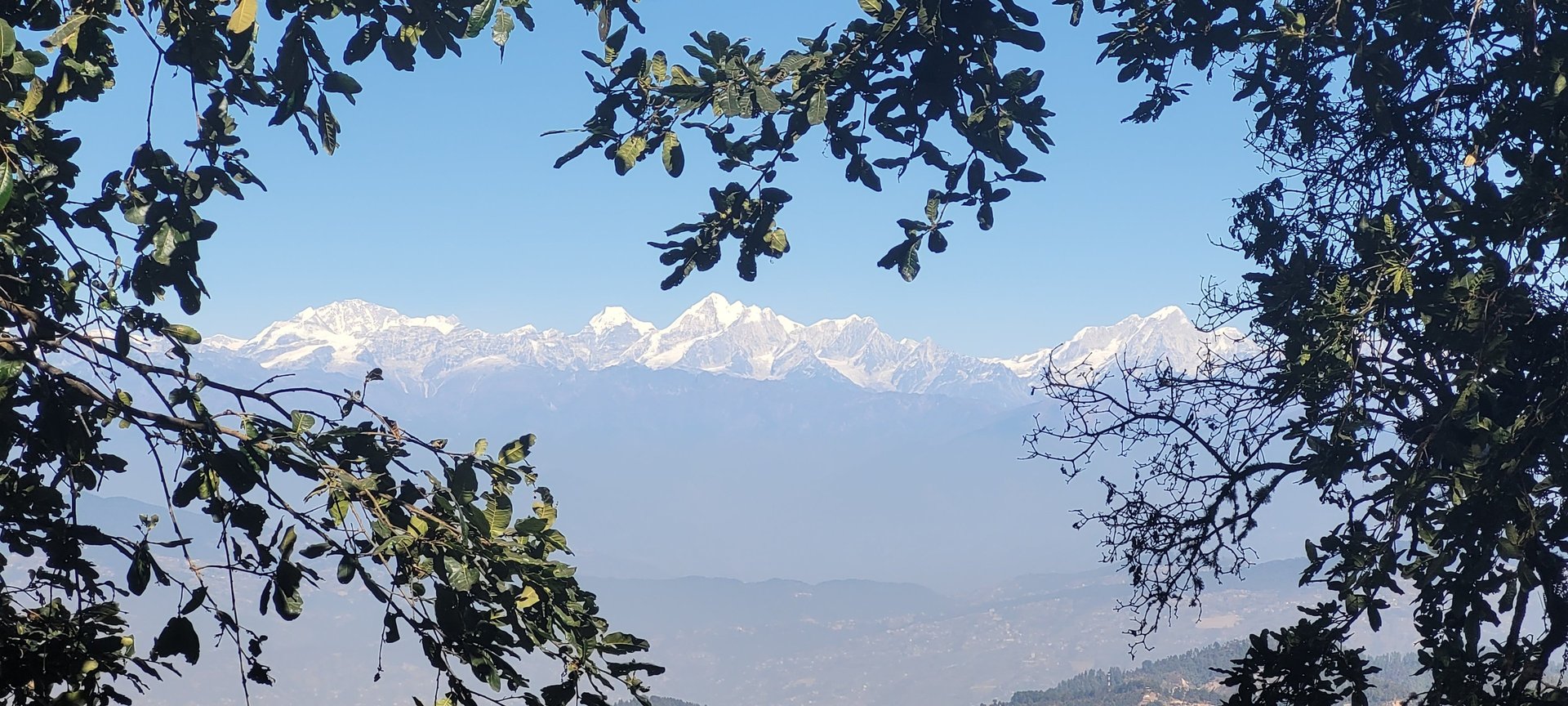After completing the Jamacho Gumba hike, we knew immediately—we didn’t need to wait long before tackling another hill. Our next challenge was clear: Phulchowki Hill (2,782m), the highest point in the Kathmandu Valley, offering a tougher yet more rewarding adventure.
On February 2nd, we set out on this hike, and to our surprise, we already spotted rhododendrons starting to bloom, hinting at the arrival of spring. Though peak rhododendron season usually begins in March and April, a few bright red flowers were already scattered along the trail, adding splashes of color to the otherwise green jungle.
Phulchowki, meaning "Hill of Flowers" in Nepali, is famous not just for its panoramic views of the Himalayas but also for its rich biodiversity. The trail is surrounded by dense subtropical forests, home to over 250 bird species, including the rare Spiny Babbler, found only in Nepal. The hill is particularly breathtaking in spring, when rhododendrons fully bloom, painting the landscape in vibrant red and pink hues.
Why Phulchowki is Important for Nepali People
For centuries, Phulchowki Hill has been a sacred site for both Hindus and Buddhists. At the summit stands the Phulchowki Mai Temple, dedicated to the goddess Phulchowki Mai, a powerful deity believed to control rainfall and protect the valley’s agriculture. Every year, during special festivals, devotees hike to the top to offer prayers, light oil lamps, and make floral offerings to seek blessings for good harvests and protection from natural disasters.
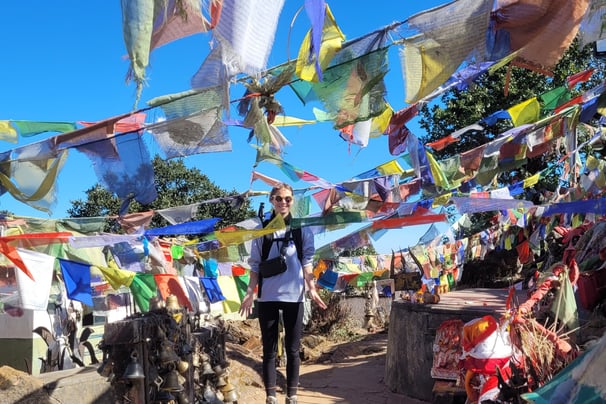

The site is also spiritually linked to the legend of the four goddess shrines (Ajimas) that guard the Kathmandu Valley from all directions. Phulchowki Mai is said to protect the southern side, with the other three deities residing at Swayambhunath (west), Nuwakot (north), and Bhaktapur (east).
Historically, Phulchowki Hill has been an important landmark for the Malla and Shah dynasties, who often visited the temple for rituals ensuring the well-being of their kingdoms. Even today, local pilgrims and monks hike to the temple, maintaining its religious significance.
But beyond its spiritual importance, Phulchowki also holds a strategic role in modern Nepal. The hilltop is home to telecommunication towers, serving as a vital relay point for radio and television broadcasts across the valley.
With its perfect blend of spiritual, historical, and natural significance, Phulchowki offers more than just a trek—it’s a journey through Nepali culture, faith, and the untouched beauty of the Himalayas.
Weather on Our Hike: A Perfect Day with a Full Himalayan Panorama
We couldn’t have asked for better weather—it was one of those rare, crystal-clear days when the entire Himalayan range revealed itself. From the very beginning of our hike, we were greeted with breathtaking views of the Langtang, Ganesh Himal, Manaslu, and even distant Everest ranges. As the day progressed, the visibility remained spectacular, and by sunset, we were rewarded with a golden-hour glow over the mountains, making every step worth it.
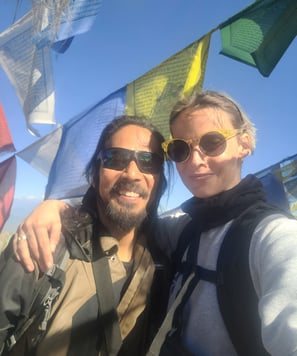

During our hike, my husband and I talked about how rare it is to witness the full Himalayan range so clearly. We both felt that hiking with open hearts and clear minds made a difference—almost as if the mountains sensed our energy and rewarded us with their presence. It was a humbling and magical experience, reminding us why we love trekking in Nepal so much.
The weather was sunny and pleasantly warm for most of the hike, especially in the forested lower sections. However, as we reached the Phulchowki peak, the conditions changed quickly—it was windy, and the temperature dropped slightly. If you’re planning this hike, a windproof jacket is essential, as the strong gusts at the top can make it feel much colder than expected.
Best Seasons to Hike Phulchowki
Autumn (October–December) – The best time for clear skies and unobstructed Himalayan views. The trails are dry, and temperatures are perfect for hiking.
Winter (January–February) – Cold (mornings and evenings) but rewarding! If you're lucky, you’ll get a full Himalayan panorama like we did, and some years, the summit even sees light snowfall.
Spring (March–April) – A magical time when rhododendrons are in full bloom, painting the trail red and pink. However, the haze in late spring can sometimes reduce visibility.
Monsoon (June–September) – Not recommended due to heavy rain, leech-infested trails, and clouds that often block the views.
For the best experience, plan your hike on a clear day and check the weather forecast in advance. Phulchowki is one of those hikes where the right weather makes all the difference!
Phulchowki Hike Overview: Everything You Need to Know
Starting Point & Route: Getting to Godavari and Beginning the Hike
Reaching the Phulchowki trailhead is quite simple, but choosing the right mode of transport can shape your experience. We opted for the local bus because, let’s be honest, taking public transport in Nepal is an adventure in itself! It’s a great way to experience daily life and save money. Since we live here, hopping on a bus is hassle-free for us, but for tourists, it might not be the most convenient option.
Local Bus & Van (Budget-Friendly Option): From the center of Kathmandu, take a local bus heading to Satdobato (a major transport hub in Lalitpur). The ride is bumpy but affordable. At Satdobato, switch to a small van bound for Godavari. Vans leave when full, so expect to wait a bit if you're traveling early or late in the day. The ride from Satdobato to Godavari takes around 25 minutes and costs just a few rupees. We paid 85 NPR for a bus and a van (for one person).
Private Vehicle (Best for Comfort & Convenience): If you prefer a more comfortable and flexible journey, hiring a private car or taxi is the best option. A taxi from Thamel to Godavari costs around NPR 1,500–2,000 (negotiable), and a private car with a driver can be arranged for a round trip, making it a stress-free experience.
Motorbike/Scooter (Great for Adventurers): If you enjoy riding, renting a scooter or motorbike is a fantastic way to reach Godavari on your own time. The roads are decent, and the ride takes about an hour from central Kathmandu. Parking is available near the entrance for an extra fee.
Let’s be real—reaching the top without breaking a sweat just doesn’t hit the same. The hike itself is the adventure, and trust me, the views, the silence of the forest, and the occasional birdcalls are way more rewarding than sitting in a bumpy car/scooter. So, unless you have mobility issues or an urgent need to get to the temple for some life-altering prayers, get out of your comfort zone and hike!
Once we arrived in Godavari, we had to walk for about 15 minutes to reach the official trailhead. There are a few different ways to start, but the correct entrance is through the left-side gate—this is your starting point for the hike.
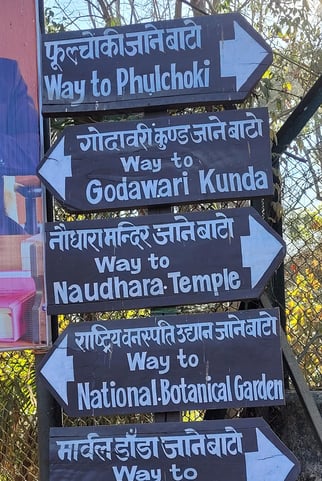

Too Lazy to Hike? There’s a Road to the Top… But Come on!
If your goal is just to visit the temple at the summit, you can actually drive all the way up. Yep, there’s a road that winds through the dense forest and takes you straight to the top, so if you’re feeling particularly allergic to hiking, you have an easy way out. But where’s the fun in that?
A Spiritual Start: Naudhara Bhawani Temple & Sacred Water Taps
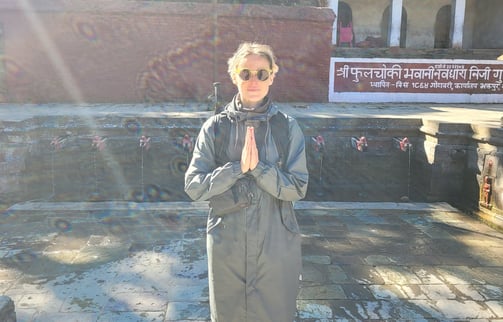

Just before officially starting the climb, we made a quick stop at the Naudhara Bhawani Temple. It’s a small but sacred Hindu temple that holds deep cultural significance for the locals. Dedicated to Goddess Bhawani, this temple is known for its nine holy water taps (Naudhara). Each tap represents different aspects of purification, and many visitors stop here to wash their faces (and symbolically, their sins) before beginning the hike. It’s a refreshing and meaningful ritual, making you feel both physically and spiritually ready for the journey ahead.
The water from these taps is believed to have purifying properties, and locals say that each tap is dedicated to a different deity. If you’re interested in immersing yourself in local traditions, it’s worth taking a moment to say a small prayer, rinse your face, or simply appreciate the peaceful atmosphere.
Timing & Recommended Start
We started our hike quite late—at 10 AM, which, looking back, wasn’t the best idea. The winter sun sets early in Nepal (around 5 PM), meaning we were on a tight schedule to make it down before dark. If you’re hiking in winter, I strongly recommend starting by 8 AM to give yourself enough time to enjoy the trek without feeling like you’re in a race against the sun. During spring and autumn, when days are longer, you have a bit more flexibility.
With lunch breaks, photos, and videos, we reached the top in 4 hours and 15 minutes. But realistically, if you take it slow and soak in the views, expect to take around 5-6 hours to reach the Phulchoki peak.
If you’re hiking back down to Godavari the same way, going downhill should take around 2 to 3 hours, depending on how much your knees decide to cooperate. Going down is faster, but that doesn’t mean it’s effortless—watch out for loose rocks and slippery patches, especially after rain. Your legs will probably complain the next day, but hey, that’s part of the fun, right?
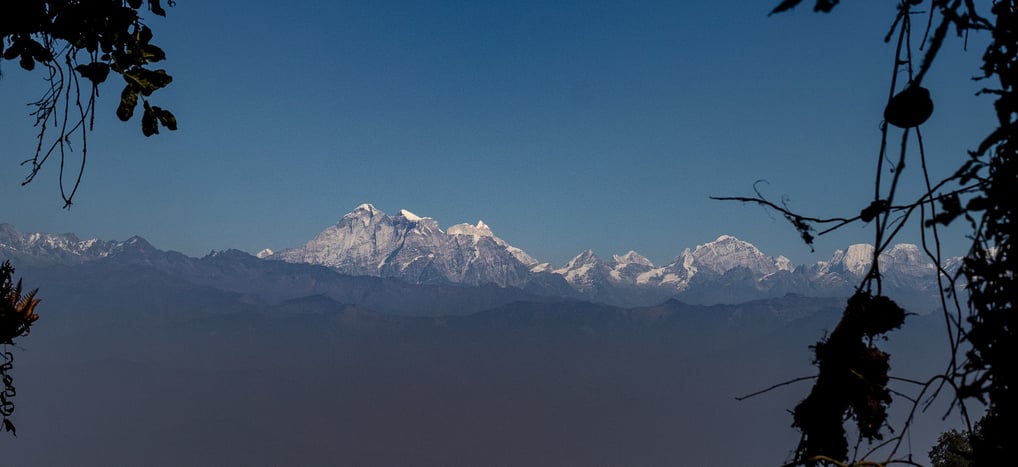

The Descent: Phulchowki to Panauti – The Less Explored Route
We decided to take a different route down, aiming for Panauti rather than heading back to Godavari. Leaving the Phulchowki peak just before 3 PM, we knew we had to pick up the pace and limit our stops to make sure we got down before the sun fully set. The first challenge? Finding the right path!
We were feeling pretty confident—we had maps.me (our trusty navigation app), but the trail was not well-marked, and we didn’t realize how old and abandoned this path was. Our first attempt led us to a bike trail. We knew we were close, but something didn’t feel right. We tried again, only to find ourselves on a completely overgrown trail that seemed to be the wrong direction. After five minutes of walking, we realized it wasn’t the right one. But—good news! The actual trail was only about two meters away from where we were standing. Guess the trail’s not too keen on being found easily.
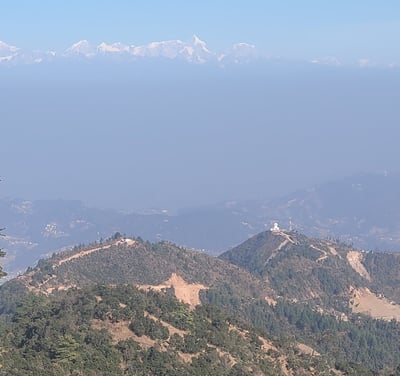

Once we were on the right path, we noticed the difference from the hike up to the peak. It felt like this trail hadn’t been used in years—there were only a few trail signs, and the landscape was distinctly different. The forest started thinning out, and open farmlands began to appear, offering a striking contrast to the dense forests we had just descended from. The golden hour made everything feel magical, with the sun casting a warm glow over the fields. The tranquility here was such a contrast to the busy trails we’d hiked before.
We had promised ourselves no more stops, but how could we resist when we were met by little puppies and their mama? Naturally, we had to share our cookies with them. We even made a promise to ourselves: next time, we’re bringing two packs of cookies—one for us, and one for the puppies.
The descent felt longer than we anticipated, but we managed to do it in about 3 hours. However, when we reached Puchhari village, locals told us we had missed the last bus. We had already hiked 22 km and though we were tired, we decided to continue walking the additional 5 km to Panauti.
Lucky us, just as we were wondering how much further we’d need to walk, a Tuk Tuk stopped and offered to take us to the Panauti bus station for just 100 NPR for both of us. Talk about a sweet ride for an unbeatable price!
The Trail: A Step Back in Time
As for the history of this old trail, it’s not one that gets much attention these days. The path is significantly less traveled compared to the more popular routes leading up to Phulchoki, which is why it felt like hiking through a forgotten piece of Nepal. It’s likely that this route was more commonly used by locals many years ago, possibly as a way to connect to Panauti and surrounding villages. The trail’s ruggedness suggests that it was once a major route for transportation before modern roads and paths took over.
The transition from dense forest to open farmland was remarkable, with the landscape changing dramatically as we moved closer to Panauti. The local farming culture is still very much alive here, and you can see the fields full of crops and animals, adding a sense of peaceful rural life to the hike’s final stage. It’s a route that offers a unique glimpse into the simpler, quieter side of Nepal, away from the bustle of Kathmandu.
I’d say this less-explored route was definitely a hidden gem—perfect for anyone who wants to experience more solitude and the feeling of hiking through history. The locals will probably tell you that it’s not often trekked, and that’s just the way we like it: fewer crowds, more adventure.
Essential Tips
What you wear depends on the season, but layers are key—mornings and evenings can get chilly even in summer. A light jacket is always a good idea, and if you’re hiking in winter, bring extra layers for warmth. Comfortable hiking shoes are a must since the terrain changes throughout the hike, from forest trails to rocky paths. Don’t forget a hat and sunscreen, as the sun can be intense, especially in the open sections of the trail.
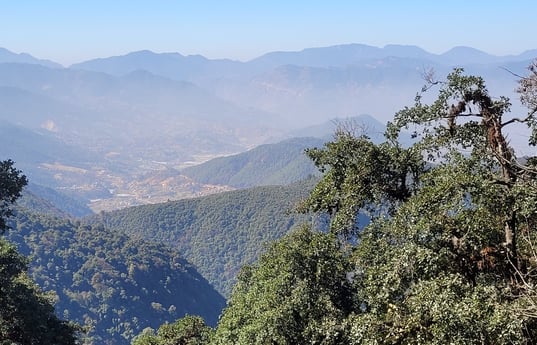

This hike is not for beginners. The ascent to Phulchowki Peak is steep and physically demanding, requiring endurance and strength. If you’re new to hiking, this might not be the best first trek to start with. However, if you’re up for a challenge, the views and sense of accomplishment at the top are more than worth the effort. The descent towards Panauti is equally tough, with uneven terrain and fewer marked trails, making navigation a bit tricky.
Bring plenty of water, but if you run out, don’t worry! Once you reach the Phulchowki peak, there’s a small shop where you can buy extra water and snacks. However, it's always best to carry enough from the start, just in case. Since this is a full-day hike, packing your lunch and snacks is essential. The trail is long, and you’ll need the energy!
For international tourists, there is a 100 NPR entrance fee, while Nepali citizens can enter for free. If you plan to stay overnight in Panauti, accommodation is not an issue—there are plenty of hotels and guesthouses, and finding a place to stay is easy.
Getting back to Kathmandu is simple. There’s a direct bus from Panauti that will take you back to the city without any hassle. By the time we reached Panauti, it was already dark. We grabbed a quick dinner, and exhaustion took over—we fell asleep almost instantly. Unfortunately, we didn’t get the chance to explore Panauti this time, as we had another hike lined up early the next morning. But that just means one thing—we’ll be back!
Final Words
This wasn’t an easy hike—let’s be honest, it was steep, long, and tested our endurance. But somehow, it felt light—inside. Maybe it was the golden light filtering through the trees, maybe it was the silence of an almost-forgotten trail, or maybe it was just one of those days when the mountains truly welcomed us.
And then, there were the Himalayas. Open, endless, breathtaking. We see them almost every day from our rooftop, yet standing there, surrounded by their vastness, felt different. It was a reminder of how small we are and how much more there is to explore.
So, if you’re up for a challenge, take this route. Hike beyond the usual trails, let the path surprise you, and trust that the mountains will reveal themselves when you’re ready. Because when they do, it’s pure magic.
पहाडबाट, सान्द्रा
From the mountains, Sandra 🙏✨


